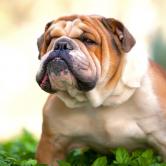Coat Colors and Patterns in English Bulldogs

Many people assume that a Bulldog is a Bulldog, but that is not strictly true. There are actually many different breeds of Bulldog and there are some subtle physical and temperamental differences between the two. Though there are a number of breeds that carry the Bulldog name, many people picture the English Bulldog when they hear the word “Bulldog.” Keep reading to learn more about the history of the English Bulldog as well as their common coat colors and patterns.
History of the Bulldog Breed
The Bulldog is one of several dogs that carry the word bulldog in their name, but there are two breeds that are commonly referred to as the “Bulldog” – the English Bulldog and the American Bulldog. The word bulldog was first mentioned in print around 1500, though the original spelling of the word was much different than the modern spelling. These dogs were given the “bull” designation because they were originally used in the sport of bull baiting in which dogs were set upon a tethered bull – the first dog to grab it by the nose and pin it to the ground was declared the winner. As one of the primary bull-baiting breeds, Bulldogs were developed to have stocky bodies, massive heads, and strong jaws.
When bull baiting was made illegal in 1835, the usefulness of the English Bulldog was a working breed began to fade. Eventually, however, emigrants brought some of the dogs over to the New World where they gradually began to gain popularity as pets. The American Kennel Club registered the first Bulldog in 1886 and the first breed club in the United States was formed in 1890. The Bulldog’s popularity has continued to rise and the breed was ranked the fourth most popular breed in the U.S. in 2015 according to AKC registration statistics.
Coat Colors and Patterns
The Bulldog’s most identifiable characteristic is his large head and wrinkled skin. In regard to other physical traits, Bulldogs usually have an upturned jaw with an underbite and a short, flat coat. The Bulldog’s coat is sleek and somewhat coarse; it sheds moderately and doesn’t require much maintenance. The main coat colors for this breed are fawn, red, and white as well as piebald and brindle. Brindle is a color pattern that consists of tiger-like stripes over a solid background. The stripes are usually irregular in color and are typically darker than the coat’s base color. Piebald is a pattern that consists of pigmented spots or splotches on an unpigmented (white) background. The AKC breed standard for the Bulldog allows for a variety of colors and markings except for merle. There are also certain regulations for patterns and markings.
Though the English Bulldog may not be one of the most attractive breeds out there with its wrinkled skin and overbite, but these dogs make wonderful pets. In addition to being friendly and mild-mannered, Bulldogs are very people-friendly and they love kids. If you’re looking for an adaptable, low-maintenance breed, consider the Bulldog.
Photo credit: Johnny Dao/Shutterstock







